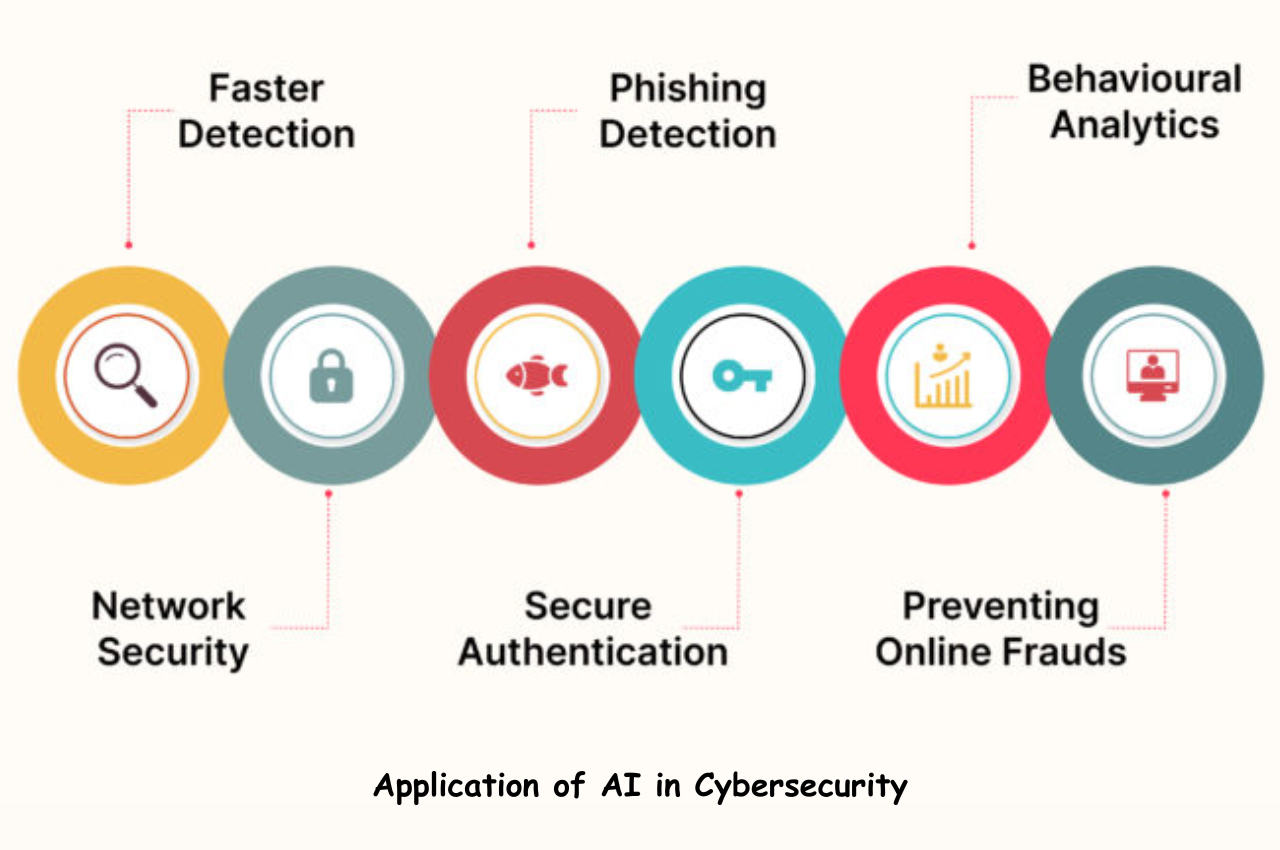AI and ML have quickly emerged as crucial technologies in the realm of cybersecurity. Given the rising volume of data and complex cyber threats, organizations and individuals rely on AI and ML to fortify their security measures. These technologies aid in the analysis of vast data sets, enabling the identification of patterns that could signify the existence of a cyber threat. Consequently, organizations can promptly and accurately detect and respond to such threats, surpassing the capabilities of conventional approaches. This article delves into the significant applications of AI in cybersecurity and the promising prospects that lie ahead for these technologies.
Thank you for reading this post, don't forget to subscribe!What is Cybersecurity?
The field of cybersecurity plays a crucial role in safeguarding internet-connected systems, encompassing hardware, software, and data, from any form of attack, damage, or unauthorized access. In recent years, the significance of cybersecurity has escalated due to the increasing reliance on online platforms for our daily activities and the storage and transmission of vital information.
Various cybersecurity threats pose a constant risk, including hacking, malware, phishing, and ransomware. Hacking involves the unauthorized intrusion into a computer system or network. Malware, on the other hand, is specifically crafted software that aims to exploit or inflict harm upon a computer or network. Phishing entails the deceptive act of masquerading as a trustworthy entity in electronic communications to acquire sensitive information like usernames, passwords, and credit card details. Lastly, ransomware is a form of malware that encrypts a victim’s files and demands payment in exchange for the decryption key.
The significance of cybersecurity extends to individuals, businesses, and governments alike. Individuals must prioritize the protection of personal information, such as financial data, identification numbers, and login credentials, to thwart cyber criminals. For businesses, it is imperative to safeguard sensitive business information and ensure uninterrupted operations in the face of potential cyber attacks. Additionally, cybersecurity holds immense importance in government and military operations, as any breach in their systems can have severe implications on national security.
How does AI work?
AI tools are commonly developed using machine learning (ML) techniques, where computer systems identify patterns in data without direct human programming. ML allows a system to autonomously learn how to extract information from data, with minimal human intervention.
Large language models (LLMs) are a form of generative AI that can produce various types of text resembling human-created content. To achieve this, an LLM is trained on a vast amount of text data, often collected from the internet. Depending on the LLM, this data may encompass web pages, scientific studies, books, and social media posts. Due to the extensive training data, it is challenging to filter out all content, leading to the potential inclusion of ‘controversial’ or inaccurate material in the model.
AI in Cybersecurity: 8 Use Cases to Know
 Artificial intelligence is the perfect playground for cybercriminals who thrive on the latest technological advancements. It empowers them to create intricate and ever-evolving malware, impersonate authoritative figures, and even replicate biometric features such as voice patterns.
Artificial intelligence is the perfect playground for cybercriminals who thrive on the latest technological advancements. It empowers them to create intricate and ever-evolving malware, impersonate authoritative figures, and even replicate biometric features such as voice patterns.
The emergence of AI in cybersecurity has evolved as an organic reaction to these novel and unforeseeable obstacles. By harnessing AI, they are able to effectively counter the malicious activities of these adversaries. Here are eight compelling use cases that shed light on how AI is utilized to outsmart the bad guys.
1. Threat Prevention and Preemption
Businesses and organizations often face continuous attacks, with cyber threats infiltrating their networks and causing havoc for extended periods before being detected. Leveraging the vast datasets of AI models, these organizations can swiftly identify abnormal behavior.
A key objective in cyber security is to proactively thwart attacks prior to their execution. This objective can be achieved with the right information at hand. For instance, a cybersecurity team can employ a proxy network to consistently extract data from hacking forums and other related websites. Armed with this valuable intelligence, they can effectively confront forthcoming attacks.
2. Timely Incident Response
Even with the assistance of AI, it is impossible to completely prevent all incoming attacks in a cybersecurity framework. There is always a possibility that an unauthorized device may be connected or a malicious code may be present in an update. Nevertheless, a strong cybersecurity AI can effectively address these incidents by promptly blocking or removing the malicious actors involved.
3. Data Protection
Data serves as the foundation for the functioning of contemporary economies. Regardless of whether it is acquired via web scraping API, surveys, routine business activities, etc., the data gathered must be adequately protected. Utilizing AI for classification and automatic encryption can enhance data security. Moreover, automating access control and ensuring compliance with data protection regulations such as the GDPR are additional measures that can be implemented.
4. Endpoint Security
PCs and smartphones serve as the bridge between secure company networks and the internet. To safeguard these endpoints, traditional antivirus and antimalware software must continuously evolve to keep up with the ever-changing threat landscape.
In the past, virus and malware protection relied on predefined lists of known threats. However, these methods have proven ineffective against AI-driven malware, which can patiently wait or disguise itself as a harmless system process. By adopting a behavior-based approach enabled by AI, cybersecurity tools can now detect and combat emerging and mutating threats by analyzing patterns and identifying malicious intent, rather than solely relying on documented viruses and malware.
5. Spam and Phishing Prevention
Detecting and eradicating spam, which posed an early threat to millions of email accounts, marked one of the early large-scale applications of AI and machine learning. Despite the continuous bombardment of spam in our daily lives, AI algorithms have evolved to a higher level of sophistication in effectively detecting and discarding it.
AIs, or more specifically, advanced language models, are breathing new life into the age-old cyber threat of phishing. In the past, recognizing phishing attempts was relatively easy, as the senders lacked the linguistic skills to create convincing messages. However, AI-powered phishing scams have become more persuasive by closely imitating human expression. Consequently, combating this menace with the same technology yields exceptional outcomes in terms of detection and prevention.
6. Advanced Multi-Factor Authentication
Password strength can vary greatly, ranging from strong and unique ones that provide solid protection to weak ones that hackers can easily bypass. Unfortunately, even the most secure passwords can still be stolen or compromised. Multi-factor authentication (MFA) serves as an additional layer of security to prevent unauthorized access in case a password is stolen or copied.
While traditional MFA methods are effective, hackers are now using AI to find ways to circumvent them. This includes traditional authentication codes and biometrics. Fortunately, AI is also playing a key role in transforming how we use biometrics for security.
An example of this is keystroke dynamics, where AI can verify a user based on their unique typing patterns. Keystroke dynamics is just one type of behavioral biometrics, which also includes other behaviors like mouse movements, screen tapping pressure on smartphones, and more.
7. User Profiling
In addition to traditional authentication methods, machine learning enables the implementation of thorough user profiling as a security measure. This involves examining the behaviors of individual users, such as consistent access to specific directories or limited service usage.
Any deviations from these established patterns could be harmless, but they could also signal a potential threat like a malicious insider or an account breach.
8. Fraud Detection
An essential requirement for any respected e-commerce venture is a reliable payment gateway. Malicious individuals may attempt to take advantage of vulnerabilities in order to carry out deceitful transactions. Artificial intelligence’s remarkable pattern recognition capabilities prove to be invaluable in this scenario. AI can effectively analyze high transaction volumes, pinpointing any irregularities while ensuring legitimate payments are processed smoothly.
These are some of the most potential use cases for AI in cybersecurity, as outlined above. We trust you have discovered some valuable insights.
Traditional Approach to Cybersecurity Before AI
Prior to the advent of AI, cybersecurity heavily relied on conventional methods. Companies utilized rule-based systems and signature-based detection techniques to pinpoint familiar threats such as viruses and malware. However, these strategies were inadequate in addressing the constantly evolving and sophisticated cyber threats. Manual examination of logs and data by human analysts often resulted in delayed responses and overlooked vulnerabilities. The absence of automation and real-time analysis posed challenges in combating rapidly changing attack methods. Moreover, the incapacity to manage large volumes of data impeded efficient threat detection and response. With the increasing complexity of cyber threats, the traditional approach struggled to keep pace, emphasizing the necessity for a more dynamic and proactive solution.
Application of AI in Cybersecurity
 Here is a few potential application of AI and Machine Learning in Cybersecurity, let’s take a look at them:
Here is a few potential application of AI and Machine Learning in Cybersecurity, let’s take a look at them:
Using ML For Malware Detection and Classification
AI in cybersecurity plays a crucial role in identifying and categorizing malicious software. By utilizing machine learning algorithms, it is possible to teach systems to identify the unique attributes of various forms of malware, including viruses, worms, and trojans. This capability allows for the real-time detection and classification of new malware strains, even those that have not been encountered before.
Adversarial ML and its Implications for Cybersecurity
Adversarial machine learning is a critical component of AI and ML that has direct implications for cybersecurity. This strategy involves training machine learning models to detect and defend against adversarial examples, which are inputs crafted to deceive the model. In the cybersecurity domain, adversarial machine learning is instrumental in identifying and protecting against adversarial attacks, such as those attempting to circumvent intrusion detection systems or deceive a system into misclassifying malware as non-threatening.
AI-based Network Traffic Analysis and Anomaly Detection
AI and ML are employed in the realm of network traffic analysis and anomaly detection as well. These cutting-edge systems leverage machine learning algorithms to scrutinize network traffic and identify any irregularities that could potentially signify a breach. For instance, ML can be utilized to identify a sudden surge in traffic originating from a specific IP address or to discern patterns of network activity that are indicative of a specific type of cyber attack.
AI-assisted Penetration Testing and Vulnerability Management
AI and ML are utilized in the domains of penetration testing and vulnerability management as well. Penetration testing involves the endeavor to gain unauthorized access to a system or network, while vulnerability management entails the identification, evaluation, and mitigation of vulnerabilities within a system or network. By employing machine learning algorithms, these processes can be automated, thereby enhancing their efficiency and effectiveness.
Real-time Threat Intelligence with Machine Learning
AI and ML are utilized in cybersecurity for real-time threat intelligence. By employing machine learning algorithms, these systems can analyze data from different sources to offer immediate threat intelligence. This capability allows organizations to promptly detect and address emerging threats.
AI-powered Security Automation and Orchestration
AI-driven security automation and orchestration represent a key area where AI and ML technologies are leveraged. By utilizing machine learning algorithms, these systems can streamline routine security operations like patch management and incident response. As a result, businesses can allocate human resources to higher-priority responsibilities.
AI-based User and Entity Behavior Analytics
AI-driven user and entity behavior analytics (UEBA) is a field where artificial intelligence and machine learning play a crucial role in cybersecurity. By employing machine learning algorithms, these systems can scrutinize the actions of users and entities within a network. This capability allows organizations to pinpoint irregularities and recognize possible risks, including insider threats and advanced persistent threats (APTs).
AI-Powered Cyber Threat Hunting
AI and ML are being increasingly utilized in cybersecurity through AI-powered cyber threat hunting, which is designed to uncover and address advanced threats that have managed to bypass conventional security measures. The primary objective of threat hunting is to pinpoint and neutralize malicious actors before they can inflict harm on an organization.
A key benefit of AI-driven threat hunting lies in its capacity to sift through vast amounts of data and pinpoint potential threats by recognizing patterns. By training machine learning algorithms to identify the characteristics of various threats like malware, phishing, or APTs, the system can swiftly identify and categorize new threats in real-time, even if they are previously unknown.
AI And ML in Intrusion Detection and Prevention Systems
AI and ML play a crucial role in cybersecurity by powering intrusion detection and prevention systems (IDPS). These systems leverage machine learning algorithms to scrutinize network traffic and pinpoint irregularities that could signal a security breach. For instance, an IDPS can utilize ML to identify abrupt spikes in traffic from a particular IP address or recognize network behavior patterns associated with a specific cyber attack.
The Benefits of AI in Cyber Security
AI has emerged as a formidable weapon in combating cyber threats, owing to its ability to swiftly identify, examine, and counteract malicious assaults.
Faster Threat Detection and Response
Utilizing AI enhances your comprehension of your networks and accelerates the detection of potential threats. AI-driven tools are capable of analyzing large volumes of data to pinpoint unusual activities and uncover malicious behavior, like a recent zero-day attack.
Additionally, AI has the capability to streamline various security procedures, including patch management, simplifying the task of managing your cybersecurity requirements.
By automating certain tasks, such as redirecting traffic from a compromised server or notifying your IT team about potential problems, AI can assist in responding promptly to cyber attacks.
Improved Accuracy and Efficiency
AI-driven cybersecurity systems offer enhanced precision and effectiveness in contrast to conventional security measures. To illustrate, AI has the capability to swiftly examine numerous devices for potential weaknesses, a task that would require human operators significantly more time to accomplish.
Additionally, AI algorithms have the ability to identify intricate patterns that may evade human detection, resulting in more precise identification of malicious behavior.
Greater Scalability and Cost Savings
Artificial intelligence has the capability to streamline monotonous security tasks, enabling organizations to allocate their valuable resources towards other crucial aspects of their business.
Additionally, AI possesses the ability to swiftly and accurately analyze massive volumes of data, surpassing human capabilities in identifying potential threats. This expedites the response time to security incidents and aids in reducing the expenses associated with defending against cyber threats.
By leveraging AI-driven tools, organizations can effectively detect malicious activities by connecting various data points, thereby enabling proactive protection of their systems. Moreover, these solutions are easily scalable, allowing for additional layers of security without incurring substantial costs related to hardware or personnel.
The Risks of Relying on AI in Cyber Security
The lightning-fast data analysis capabilities of AI offer unmatched protection against cyber attacks, leading companies across the globe to make substantial investments in its implementation.
However, despite the growing dependence on AI for enhancing security, there remain inherent risks associated with relying solely on this technology.
Bias and Discrimination in Decision-Making
AI systems may exhibit biased decision-making due to factors such as skewed data sets or algorithms lacking objectivity.
Failure to address these biases can result in discriminatory outcomes that impact specific groups or individuals, with serious implications for the organization.
An instance of biased decision-making by an AI system could result in erroneous judgments, preventing legitimate users from utilizing company resources and causing a decline in productivity or customer base.
Lack of Explainability and Transparency
The lack of transparency in the algorithms utilized to assess security threats can leave individuals susceptible to potential bias or manipulation. The complexity of AI makes it challenging to comprehend the rationale behind decisions made or identify areas for improvement.
Insufficient comprehension can result in detrimental choices, thereby posing significant consequences for an organization’s security.
It is possible for AI-driven cybersecurity solutions to occasionally fail in accurately detecting all threats or potential breaches, which may result in unnoticed risks and subsequent harm.
Potential for Misuse or Abuse
This technology offers benefits not only to the good guys but also to others.
Malicious actors find AI algorithms appealing as they can swiftly search through data, identify patterns, and potentially exploit them to gain access to sensitive information or launch attacks on infrastructure.
Future of AI in Cybersecurity
 The future holds immense promise and excitement for AI and ML in the realm of cybersecurity. Below are some instances of how these innovations may bolster the security of both organizations and individuals.
The future holds immense promise and excitement for AI and ML in the realm of cybersecurity. Below are some instances of how these innovations may bolster the security of both organizations and individuals.
Autonomous Security Systems
AI and ML have the potential to develop independent security systems that can operate autonomously and make decisions without human intervention. This capability would empower organizations to promptly address threats, even in the absence of human operators.
Predictive Threat Intelligence
By leveraging AI and ML, organizations can analyze data from diverse sources and obtain predictive threat intelligence. This would equip them to proactively anticipate and prepare for emerging threats before they materialize.
Advanced Threat Hunting
The utilization of AI and ML can lead to the creation of advanced threat-hunting systems capable of detecting and responding to unknown threats. This would enable organizations to stay one step ahead of attackers who continuously adapt their tactics.
AI-Driven Incident Response And Forensics
Through the automated analysis of data from various sources, such as network traffic, endpoint data, and logs, AI and ML can swiftly identify and respond to threats in real time. This would empower organizations to rapidly contain and investigate incidents.
Automated Compliance And Governance
AI and ML can automate the compliance and governance process by continuously monitoring and reporting on security controls, as well as identifying potential violations. This streamlines the process and ensures adherence to security protocols.
AI-Powered Security Automation And Orchestration
By automating repetitive security tasks like patch management and incident response, AI and ML liberate human resources to focus on more critical responsibilities. This enhances productivity and allows for a more efficient allocation of resources.
The Intersection of AI And Blockchain
The combination of AI and blockchain technology offers a secure and decentralized approach to cybersecurity, particularly in areas such as identity and access management, secure data sharing, and secure payment systems. This fusion enhances overall cybersecurity measures.
AI-Driven Security Operations Centers (SOC)
AI and ML can enhance the efficiency and effectiveness of security operations centers (SOCs) by automating repetitive tasks, analyzing data from multiple sources, and providing real-time threat intelligence. This optimization enables SOCs to operate at peak performance.
The Bottom Line on AI in Cybersecurity
AI and ML play a crucial role in enhancing cybersecurity, as highlighted earlier. These technologies aid in fortifying the security measures of both organizations and individuals through automation of routine tasks, malware detection and classification, network traffic analysis, and threat identification.
The outlook for AI and ML in cybersecurity appears bright, offering the possibility of further task automation and improved system efficiency and effectiveness.
It is imperative for organizations to thoughtfully evaluate these aspects when integrating AI and ML into their cybersecurity strategies, ensuring they complement other security protocols in place.
Technocommy is a connecting space, the leading growth and networking organization for business owners and leaders. Do I qualify?


